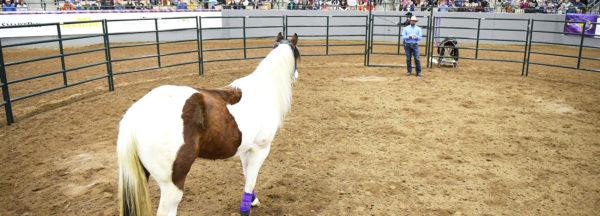Horse Has No Draw in the Round Pen


Horse Has No Draw in the Roundpen - Q&A With Clinton Anderson
Clinton Anderson from Downunder Horsemanship has developed a way to train horses, regardless of their past problems or traumas. It begins with training the owners to gain their horses’ respect and understand how to control them properly. Join Clinton on his weekly endeavors to tackle some of the most challenging situations with problem horses and problem owners. This week, we watch as Clinton gives another viewer some much-needed advice.
The viewer starts by explaining that they have a 7-year-old mare who has recently begun training using the Downunder Horsemanship Method. It’s the fourth horse this viewer has started, and she’s going on the sixth session of roundpen work, but she still can’t get her mare to follow her. She’s had success with some of the exercises, but her mare won’t take a step toward her while working on the roundpenning exercises, and she’s stuck. The viewer is worried about her mare shutting down due to overexertion in the roundpen. What should she do? Move on for now and revisit it later, or keep going until the exercise is successful?
Clinton clarifies that the horsewoman is referring to her mare’s draw—the desire for a horse to walk up to their trainer or follow them around the roundpen. Instead of doing that, this mare stops and faces her owner but won’t move toward her.
According to Clinton, there are a few things you can do to help encourage your horse to start taking steps toward you. First, you’ll want to put a halter on your horse and leave it on as you work through the roundpenning exercises. After moving the horse around the roundpen, ask him to stop and face you. Cue him to draw up to you, and if he doesn’t, then walk up to him, grab the halter, and lead him to the center of the roundpen. Let him rest with his head in the middle of your chest as you give him some love. The key to getting your horse to want to follow you is to connect you with oxygen. You need to be associated with rest, so he starts to crave coming over to you. Spend 10 or 15 minutes doing this to reinforce it. Move the horse off around the roundpen, and then stop and repeat drawing him to the center of the pen with you. Anytime your horse doesn’t come to you, use the halter to bring him up to you.
In the worst-case scenario, you can use a halter and lead rope on your horse. Continue doing the roundpenning exercises as you normally would (while holding onto the lead rope) but acting as if it wasn’t connected. When you’re ready to draw him up to you, you can use the lead rope to help you if needed. You may have to walk backward a bit and draw him all the way up to you. Once you’ve drawn him all the way up to you, let him rest with his head in the center of your chest and rub on him. Remember, the key is connecting air and rest with you, so give him time.
Clinton also says that it’s not a huge deal if your horse isn’t following you around perfectly. As long as he’s giving you his eyes and making some progress, it’s OK to move on to the next exercise in the Method. You can revisit this issue throughout your training to help your horse associate you with rest. After you go through the Method, you might try this exercise again and see completely different results without having done more work on it specifically. Usually, this is because you’ve built up trust with your horse and respect in the relationship. Your horse will feel more comfortable with you, and you’ll notice some pretty substantial improvements. The halter in the beginning is a bit of a cheat move, but once you start putting in the work, you’ll notice some pretty great improvements. And, with every session, reserve the last 10 minutes as rest so you can really start to build up that connection with your horse.
To learn more about the Downunder Horsemanship training method, become a member of the No Worries Club, or get information on any of the products featured on our show, visit our homepage and download the Downunder Horsemanship app today!

